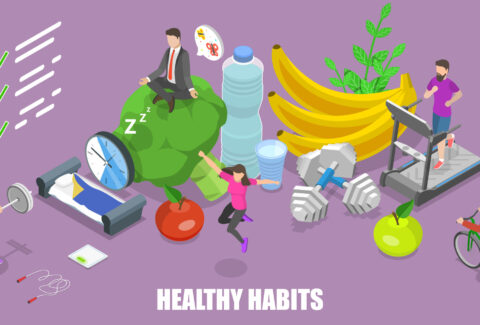From Fast Food to Fresh: Easy Swaps to Eat Healthier Without Giving Up Flavor
Eating healthy doesn’t mean sacrificing flavor or giving up your favorite foods. The secret to long-term health isn’t about restrictive dieting—it’s about making smart, sustainable swaps that enhance both taste and nutrition. With small adjustments to your daily meals, you can enjoy a diet rich in nutrients while still savoring every bite.
Many of the lifestyle changes we’ve discussed in 5 Small Changes to Build Healthy Habits That Last a Lifetime also apply to nutrition. With the right approach, you can transition from processed, fast food to fresh, whole foods without feeling like you’re missing out. Let’s explore simple, flavorful ways to make your meals healthier.
1. Understanding Why Fast Food Falls Short
Fast food is convenient, but it often lacks essential nutrients while being high in unhealthy fats, sugar, and sodium. Consuming too much fast food can contribute to weight gain, increased risk of chronic diseases, and decreased energy levels.
The Hidden Dangers of Fast Food:
- High in trans fats and refined oils – Linked to heart disease and inflammation.
- Excess sugar and refined carbs – Leads to blood sugar spikes and crashes, affecting mood and focus.
- Artificial additives and preservatives – Can disrupt digestion and metabolic health.
Fast food might be convenient, but real energy comes from fresh, nutrient-dense meals.
For those struggling with low energy levels, a better diet paired with The Sleep Cheat Code: How Better Rest Boosts Your Energy, Mood, and Health can dramatically improve how you feel throughout the day.
2. Easy Swaps to Make Your Favorite Meals Healthier
The best way to transition to a healthier diet is to start small. Instead of eliminating your favorite foods, swap them for better alternatives that provide more nutrients and fewer processed ingredients.
Simple and Tasty Swaps:
- Instead of white bread → Choose whole grain or sourdough for better digestion and more fiber.
- Instead of soda → Opt for sparkling water with fruit slices to cut sugar without losing flavor.
- Instead of deep-fried foods → Try air frying or baking for a crispy texture with less oil.
- Instead of processed sauces → Use homemade versions with natural ingredients to avoid hidden sugars and preservatives.
Healthy eating isn’t about cutting out—it’s about swapping up!
If you want to boost your metabolism along with better food choices, incorporating regular movement is key. Check out Why Exercise is the Ultimate Power-Up for Teens to see how physical activity enhances digestion and overall health.
3. Making Smart Choices When Eating Out
We all enjoy dining out, but restaurant meals can be loaded with excess calories, unhealthy fats, and sodium. However, you can still make smart choices while enjoying your meal.
How to Order Healthier at Restaurants:
- Choose grilled over fried – Grilled meats and veggies retain flavor without the extra grease.
- Ask for dressings and sauces on the side – This helps control portions and reduce unnecessary calories.
- Opt for water or herbal teas over sugary drinks – Staying hydrated improves digestion and curbs cravings.
- Check portion sizes – Restaurant servings are often larger than needed, so consider sharing a meal or saving half for later.
Eating out doesn’t have to derail your goals—just tweak your order to stay on track.
Proper hydration plays a huge role in digestion and energy levels. If you’re not drinking enough water, read Why Staying Hydrated is a Game-Changer for Your Health to understand its impact on metabolism and mood.
4. Meal Prep: The Secret Weapon for Healthy Eating
One of the best ways to eat healthier without stress is by planning your meals ahead of time. Meal prepping ensures you have nutritious, delicious options readily available, making it easier to avoid fast food temptations.
How to Start Meal Prepping:
- Batch cook grains and proteins – Cook a big batch of quinoa, brown rice, or chicken to use throughout the week.
- Pre-cut fruits and veggies – Having fresh produce ready makes healthy snacking effortless.
- Portion meals in containers – This makes grab-and-go lunches simple and balanced.
- Make overnight oats or smoothie bags – Quick, nutritious breakfast options to save time in the morning.
Meal prep today, less stress tomorrow!
If stress is a factor in making unhealthy choices, check out Why Stress Sucks for Your Health and How to Manage It to learn how mindfulness can help you stay on track with healthy eating habits.
5. Healthy Snacking: The Key to Staying on Track
Snacking doesn’t have to be unhealthy—there are plenty of tasty and nutritious options that will keep you satisfied between meals.
Smart Snack Options:
- Instead of chips → Try roasted chickpeas or nuts for protein and crunch.
- Instead of candy → Go for dark chocolate or fruit for natural sweetness.
- Instead of store-bought granola bars → Make homemade energy bites with oats, nut butter, and honey.
- Instead of ice cream → Enjoy Greek yogurt with berries for probiotics and protein.
Snack smart, stay satisfied, and fuel your body the right way.
Building healthy snacking habits also supports long-term health and weight management. If you’re curious about how these habits can prevent disease, read Why Healthy Habits Today Can Protect You from Diseases Tomorrow to understand the bigger picture.
The Bottom Line: Healthy Eating is About Balance
Transitioning from fast food to fresh meals doesn’t mean giving up flavor or enjoyment—it means making mindful choices that nourish your body while still being delicious. Small, consistent swaps can lead to big health improvements over time.
As seen in 5 Small Changes to Build Healthy Habits That Last a Lifetime, forming habits that stick is the key to long-term success. By making simple food swaps, staying hydrated, and choosing fresh ingredients, you can eat healthier without ever feeling deprived.
What’s one food swap you’re excited to try? Share your journey with us on social media, and let’s make healthy eating easy and delicious together!








